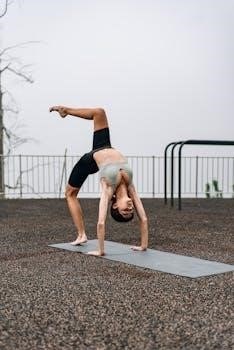Ashtanga Yoga Primary Series⁚ A Comprehensive Guide (PDF Focus)
Embark on a transformative journey into Ashtanga Yoga’s Primary Series, often referred to as Yoga Chikitsa, with our comprehensive guide․ This resource focuses on providing accessible PDF materials, including asana charts, vinyasa counts, and alignment guides․ Explore the foundational postures and sequences․
Ashtanga Yoga, a dynamic and powerful practice, is rooted in ancient Indian traditions and systematized by Sri K․ Pattabhi Jois․ This method involves synchronizing breath with a progressive series of postures, producing internal heat, purification, and profound mental clarity․ Ashtanga, often referred to as Ashtanga Vinyasa Yoga, emphasizes the importance of the vinyasa system, linking each movement to an inhalation or exhalation, creating a flowing meditative sequence․
Central to Ashtanga is the concept of Tristhana, encompassing posture (asana), breathing technique (pranayama), and gaze point (drishti)․ These three aspects work synergistically to cultivate focus, control, and self-awareness․ The practice begins with Surya Namaskar A and B, followed by a predetermined sequence of standing, seated, and finishing postures․
The Primary Series, known as Yoga Chikitsa, is designed to detoxify and align the body․ It lays the foundation for more advanced sequences․ PDF resources often provide detailed asana charts, vinyasa counts, and alignment cues, serving as valuable tools for both beginners and experienced practitioners seeking to deepen their understanding and refine their practice․ The systematic nature of Ashtanga makes it accessible through various learning resources․
The Primary Series (Yoga Chikitsa) Overview
The Primary Series of Ashtanga Yoga, also known as Yoga Chikitsa, which translates to “yoga therapy,” serves as the foundational sequence in this dynamic practice․ This series is meticulously designed to realign the body, detoxify internal organs, and build a strong, stable base for more advanced postures and sequences․
Yoga Chikitsa begins with a set sequence of Sun Salutations (Surya Namaskar A and B), followed by a progression of standing postures, seated postures, and a concluding finishing sequence․ Each posture is linked to the next through a specific vinyasa, a synchronized movement and breath pattern, creating a continuous flow of energy and heat throughout the body․ The vinyasa system helps to maintain focus, build strength, and cultivate mindfulness․
PDF resources are invaluable for understanding the Primary Series, providing detailed asana charts, vinyasa counts, and alignment cues․ These resources often include modifications for various postures, making the practice accessible to individuals with varying levels of flexibility and strength․ The Primary Series focuses on forward folds, hip openers, and twists, promoting flexibility, improving digestion, and calming the nervous system․ The consistent practice of Yoga Chikitsa lays the groundwork for physical and mental well-being․
Surya Namaskar A and B⁚ Vinyasa Count and Importance
Surya Namaskar A and B, the Sun Salutations, are the cornerstones of the Ashtanga Yoga Primary Series․ These sequences are not merely warm-ups but are integral to the practice, preparing the body and mind for the asanas that follow․ In Ashtanga, Surya Namaskar A is performed five times, consisting of nine vinyasas, while Surya Namaskar B is also performed five times, comprising seventeen vinyasas․
The vinyasa count in each Sun Salutation is crucial․ Each movement is synchronized with the breath, creating a meditative flow that generates internal heat, detoxifies the body, and cultivates focus․ Surya Namaskar A emphasizes forward folds and back extensions, building core strength and flexibility․ Surya Namaskar B introduces the chair pose (Utkatasana) and warrior pose (Virabhadrasana A), further enhancing strength and stamina․
PDF resources provide detailed breakdowns of each vinyasa, including the correct breathing technique and drishti (gaze point)․ These resources often include visual aids to ensure proper alignment and prevent injuries․ The consistent practice of Surya Namaskar A and B is essential for developing the physical and mental discipline required for the Primary Series, establishing a strong foundation for the entire Ashtanga practice․ They help to build stamina and mental focus․
Standing Asanas⁚ Alignment and Benefits (PDF Charts)
The standing asanas in the Ashtanga Primary Series form a crucial foundation, building strength, balance, and flexibility․ These postures prepare the body for the more demanding seated and finishing sequences․ Proper alignment is paramount to prevent injuries and maximize the benefits of each asana․
Key standing poses include Trikonasana (Triangle Pose), Parivrtta Trikonasana (Revolved Triangle Pose), Parsvakonasana (Side Angle Pose), Virabhadrasana (Warrior Pose), and Ardha Baddha Padmottanasana (Half Bound Lotus Standing Forward Bend)․ Each asana targets specific muscle groups and energy channels, promoting physical and mental well-being․ PDF charts are invaluable resources, providing visual guides to correct alignment, vinyasa counts, and drishti points for each pose․
These charts often include modifications for beginners, ensuring accessibility for all levels․ The benefits of the standing series extend beyond physical strength and flexibility․ They improve balance and coordination, enhance focus and concentration, and cultivate a sense of grounding and stability․ Regular practice of these asanas can also alleviate lower back pain, improve posture, and increase energy levels․ Downloadable PDF resources offer detailed instructions and illustrations, enabling practitioners to deepen their understanding and refine their technique, ensuring safe and effective practice․
Seated Asanas⁚ Key Poses and Modifications (PDF Resources)
The seated asanas of the Ashtanga Primary Series deepen flexibility, particularly in the hamstrings and hips, while cultivating internal awareness․ This segment focuses on postures like Paschimottanasana (Seated Forward Bend), Baddha Konasana (Bound Angle Pose), and Janu Sirsasana (Head-to-Knee Pose), demanding both physical endurance and mental focus․ PDF resources are essential for understanding the intricacies of each pose․
These downloadable guides provide detailed instructions, alignment cues, and modifications to accommodate varying levels of flexibility and experience․ Modifications are crucial for beginners or individuals with physical limitations, ensuring a safe and accessible practice․ For example, using a strap in Paschimottanasana can help maintain proper spinal alignment while gradually increasing hamstring flexibility․
Key poses like Marichyasana (various twists) and Garbha Pindasana (Embryo in the Womb Pose) challenge the practitioner both physically and mentally․ PDF resources often include visual aids, highlighting the correct spinal alignment, shoulder positioning, and engagement of bandhas (energy locks)․ These resources emphasize the importance of breath awareness throughout the seated series, helping to deepen the stretch and promote relaxation․ By utilizing these PDF resources, practitioners can safely explore the seated asanas, reaping the benefits of increased flexibility, improved posture, and enhanced body awareness, fostering a deeper connection to the practice;

Finishing Sequence⁚ Purpose and Postures (Downloadable Guides)
The finishing sequence in the Ashtanga Primary Series is designed to calm the nervous system, integrate the benefits of the practice, and prepare the body for rest․ This sequence typically includes backbends like Urdhva Dhanurasana (Wheel Pose), followed by inversions such as Sarvangasana (Shoulder Stand) and Halasana (Plow Pose), and concluding with Savasana (Corpse Pose)․ The downloadable guides available in PDF format provide essential information on the purpose and proper alignment of each posture․

These guides detail the specific benefits of each asana, such as Urdhva Dhanurasana’s role in invigorating the spine and opening the chest, or Sarvangasana’s ability to calm the mind and improve circulation․ They also offer modifications for practitioners with varying levels of experience, ensuring that the sequence is accessible to all․ Furthermore, these PDF resources often include vinyasa counts and breathing instructions, helping practitioners to flow seamlessly through the sequence with proper technique․
By understanding the purpose and proper execution of each posture in the finishing sequence, practitioners can maximize the benefits of their Ashtanga practice․ The downloadable guides serve as invaluable resources for both beginners and experienced practitioners, providing the knowledge and support needed to safely and effectively complete the Primary Series, leaving them feeling balanced, grounded, and rejuvenated, ready to face the world with renewed energy and focus․

Vinyasa⁚ Linking Movement and Breath
In Ashtanga Yoga, vinyasa is the vital element that synchronizes movement with breath, creating a flowing and dynamic practice․ Each movement is linked to a specific inhalation or exhalation, generating internal heat and purifying the body․ This breath-synchronized movement enhances focus, builds strength, and promotes cardiovascular health․ The vinyasa system connects each asana in the Primary Series, creating a continuous and meditative flow․
The correct vinyasa count is crucial for maintaining the rhythm and intensity of the practice․ PDF resources often provide detailed vinyasa charts, outlining the precise breath and movement sequence for each asana․ These charts are invaluable for practitioners seeking to deepen their understanding of the Ashtanga method and refine their technique․ By following the vinyasa count, practitioners can ensure they are moving with intention and awareness, maximizing the benefits of each posture․
Vinyasa also serves as a tool for self-assessment․ When the breath becomes labored or the mind wanders, it signals the need to adjust the practice․ By paying attention to the breath, practitioners can cultivate a deeper connection to their bodies and minds, fostering a sense of presence and equanimity․ Regular practice of vinyasa leads to increased physical and mental resilience, allowing practitioners to navigate challenges with greater ease and grace, both on and off the mat․
Drishti⁚ The Gaze Point in Each Asana (PDF Visual Aids)
Drishti, or focused gaze, is an integral component of Ashtanga Yoga, directing both physical alignment and mental concentration․ By fixing the eyes on a specific point in each asana, practitioners cultivate a steady mind and prevent the gaze from wandering, which can lead to mental distractions․ Consistent application of drishti enhances focus, improves balance, and deepens the meditative aspects of the practice․
Each asana in the Primary Series is associated with a particular drishti point, such as the nose, navel, toes, or third eye․ PDF visual aids often provide charts that clearly illustrate the correct drishti for each posture․ These charts serve as valuable references for practitioners, especially beginners, who may find it challenging to remember the gaze point for every asana․ By consistently practicing with the correct drishti, practitioners train their minds to remain present and attentive, even in challenging poses․
Furthermore, drishti aids in proper alignment․ When the gaze is focused, the body naturally aligns itself to support the posture, preventing strain and injury․ This mindful alignment promotes greater stability and allows practitioners to access the deeper benefits of each asana․ Over time, the practice of drishti extends beyond the yoga mat, fostering a sense of inner stillness and clarity in daily life, enabling practitioners to navigate the world with greater awareness and intention․
Bandhas⁚ Energy Locks and Their Role
Bandhas, often described as energy locks, play a crucial role in Ashtanga Yoga, influencing the flow of prana (life force) within the body․ These internal muscular engagements support postural alignment, enhance stability, and deepen the overall practice․ Three primary bandhas are emphasized⁚ Mula Bandha (root lock), Uddiyana Bandha (abdominal lock), and Jalandhara Bandha (throat lock), though the latter is less emphasized in the Primary Series․
Mula Bandha involves the contraction of the perineum muscles, located between the anus and genitals․ Activating Mula Bandha provides a stable foundation, preventing energy from dissipating downward and promoting grounding․ Uddiyana Bandha is engaged by drawing the lower abdomen inward and upward, supporting the spine, stimulating internal organs, and facilitating deeper exhalations․
Engaging the bandhas requires subtle awareness and practice․ In Ashtanga, bandhas are ideally engaged throughout the entire practice, from the opening Sun Salutations to the final resting pose․ The consistent application of bandhas not only supports physical stability but also cultivates inner heat, purifies the nervous system, and enhances mental focus․ Resources, including PDF guides, provide detailed instructions and visualizations to help practitioners understand and effectively engage these essential energy locks, fostering a more profound and transformative yoga experience․
Common Mistakes and How to Avoid Them (PDF Troubleshooting)
Practicing the Ashtanga Primary Series can be challenging, and it’s common to encounter difficulties along the way․ This section addresses frequent mistakes and provides practical solutions to enhance your practice․ Often, practitioners struggle with alignment in standing poses, such as Trikonasana and Virabhadrasana, leading to strain and potential injury․ Ensure proper alignment by focusing on grounding through the feet, engaging the core, and maintaining a straight spine․
Another common mistake is rushing through the vinyasas, sacrificing breath and alignment for speed․ Emphasize the synchronization of breath and movement, allowing each transition to be mindful and controlled․ Neglecting the bandhas, the internal energy locks, can also hinder progress․ Actively engage Mula Bandha and Uddiyana Bandha to support the spine, stabilize the core, and direct energy flow․
Tight hamstrings can restrict forward folds, like Paschimottanasana․ Modify poses by bending the knees slightly to protect the lower back and gradually increase flexibility over time․ Our downloadable PDF troubleshooting guide offers detailed illustrations, step-by-step instructions, and modifications for various poses, helping you identify and correct common errors․ By addressing these mistakes, you can cultivate a safer, more sustainable, and ultimately more rewarding Ashtanga practice․

Benefits of Practicing the Primary Series
The Ashtanga Yoga Primary Series, also known as Yoga Chikitsa, offers a multitude of benefits for both the body and mind․ Regular practice cultivates physical strength, flexibility, and endurance․ The dynamic sequences generate internal heat, promoting detoxification and improved circulation․ Asanas like Trikonasana and Virabhadrasana enhance balance and stability, while forward folds such as Paschimottanasana increase hamstring flexibility and calm the nervous system․
Beyond the physical, the Primary Series fosters mental clarity, focus, and self-awareness․ The synchronization of breath and movement, known as Vinyasa, cultivates a meditative state, reducing stress and anxiety․ The practice encourages discipline and consistency, building resilience and mental fortitude․ Regular engagement with the Primary Series can lead to improved sleep quality, enhanced energy levels, and a greater sense of overall well-being․
Moreover, the Primary Series serves as a foundation for deeper exploration of Ashtanga Yoga․ By mastering the fundamental postures and sequences, practitioners can safely progress to more advanced series․ The downloadable PDF resources available offer detailed insights into the postures, alignment, and benefits, empowering you to deepen your understanding and maximize the transformative potential of your practice․ Embrace the Primary Series and unlock its profound benefits for your body, mind, and spirit․
Resources for Learning⁚ Ashtanga Yoga PDFs and Studios
Embarking on the Ashtanga Yoga journey requires reliable resources, and thankfully, numerous options are available for both self-study and guided practice․ For those seeking to learn at their own pace, a wealth of Ashtanga Yoga PDFs can be found online, offering detailed asana charts, vinyasa counts, and alignment cues․ These downloadable guides provide a convenient way to study the Primary Series, allowing you to deepen your understanding of each posture and its corresponding transitions․
Many reputable yoga studios also offer Ashtanga classes, catering to practitioners of all levels․ Led classes provide a structured approach to learning the sequence, while Mysore-style classes offer personalized instruction and guidance․ Studios often supplement their in-person offerings with online resources, such as video tutorials and downloadable PDFs, further enhancing the learning experience․ Look for studios that emphasize proper alignment and breathwork, ensuring a safe and effective practice․
Consider exploring resources from certified Ashtanga teachers, such as those affiliated with the KPJAYI (Krishna Pattabhi Jois Ashtanga Yoga Institute), to ensure you are learning authentic techniques․ Whether you prefer self-directed study with PDFs or guided practice in a studio setting, the key is to find resources that resonate with your learning style and support your growth on the Ashtanga path․ Utilize these tools to deepen your knowledge, refine your practice, and unlock the transformative benefits of this dynamic yoga system․
